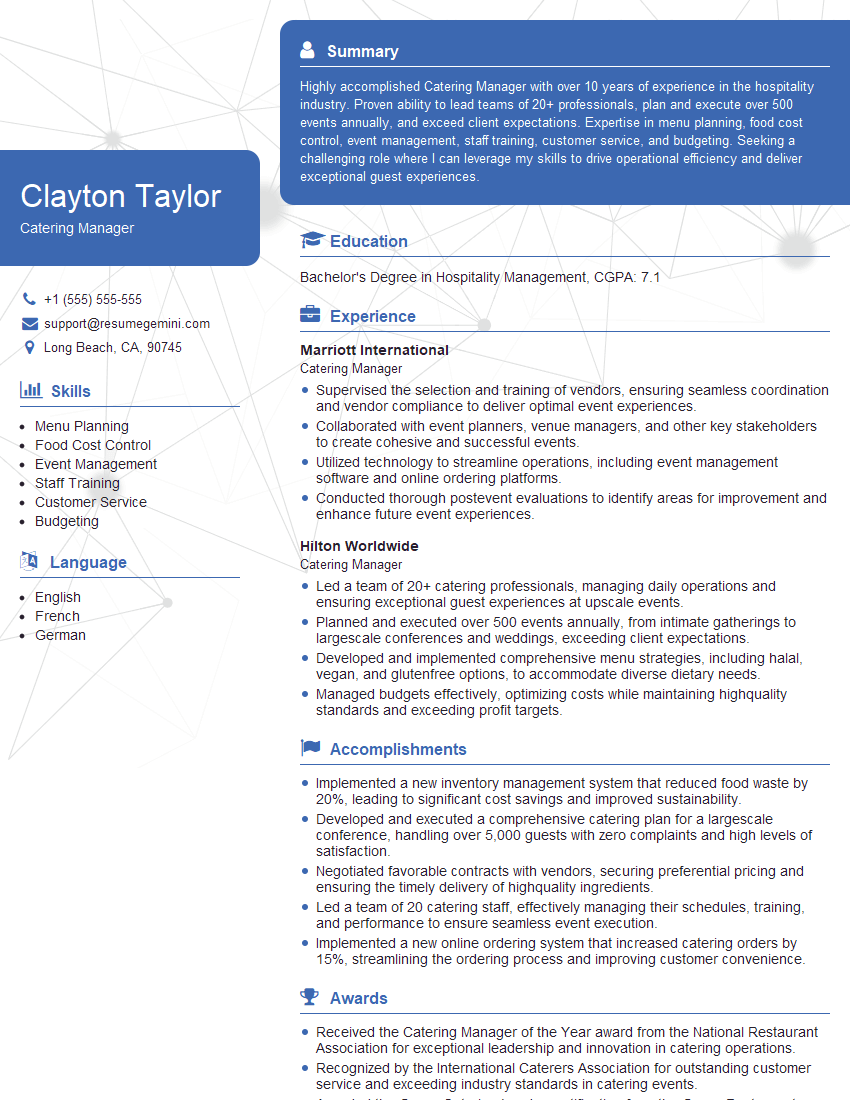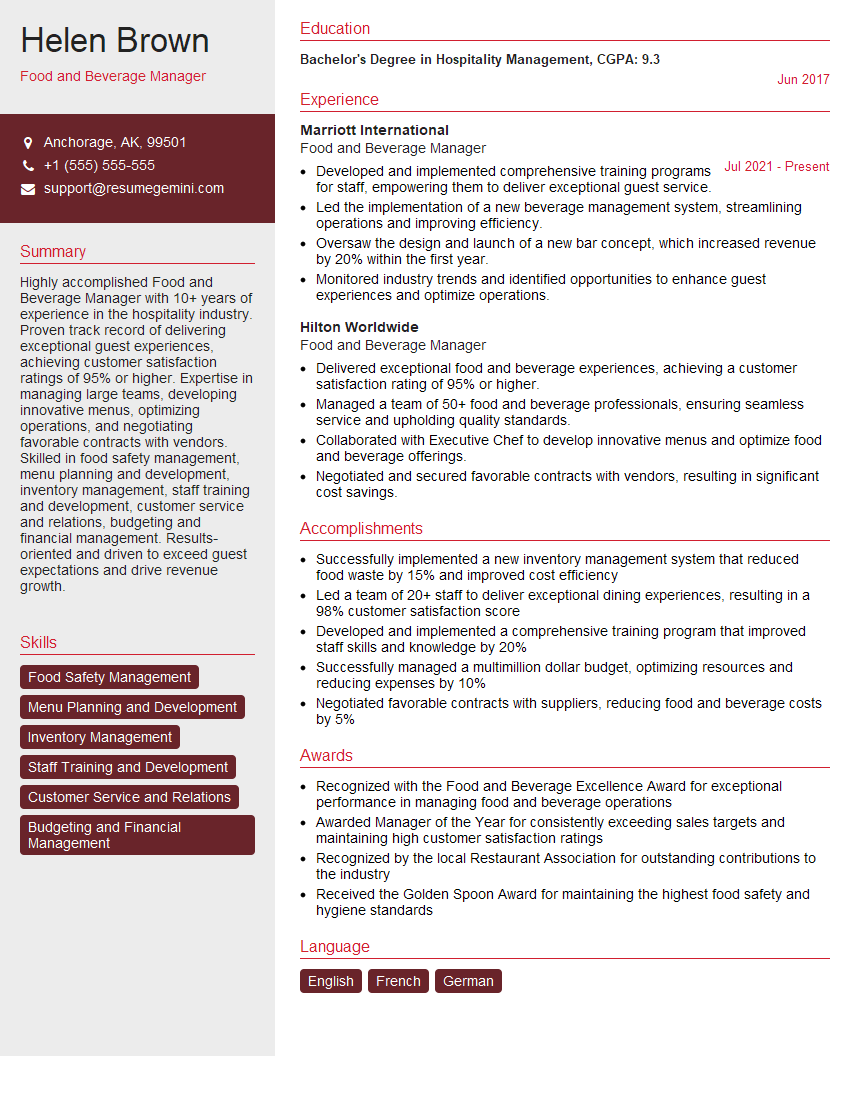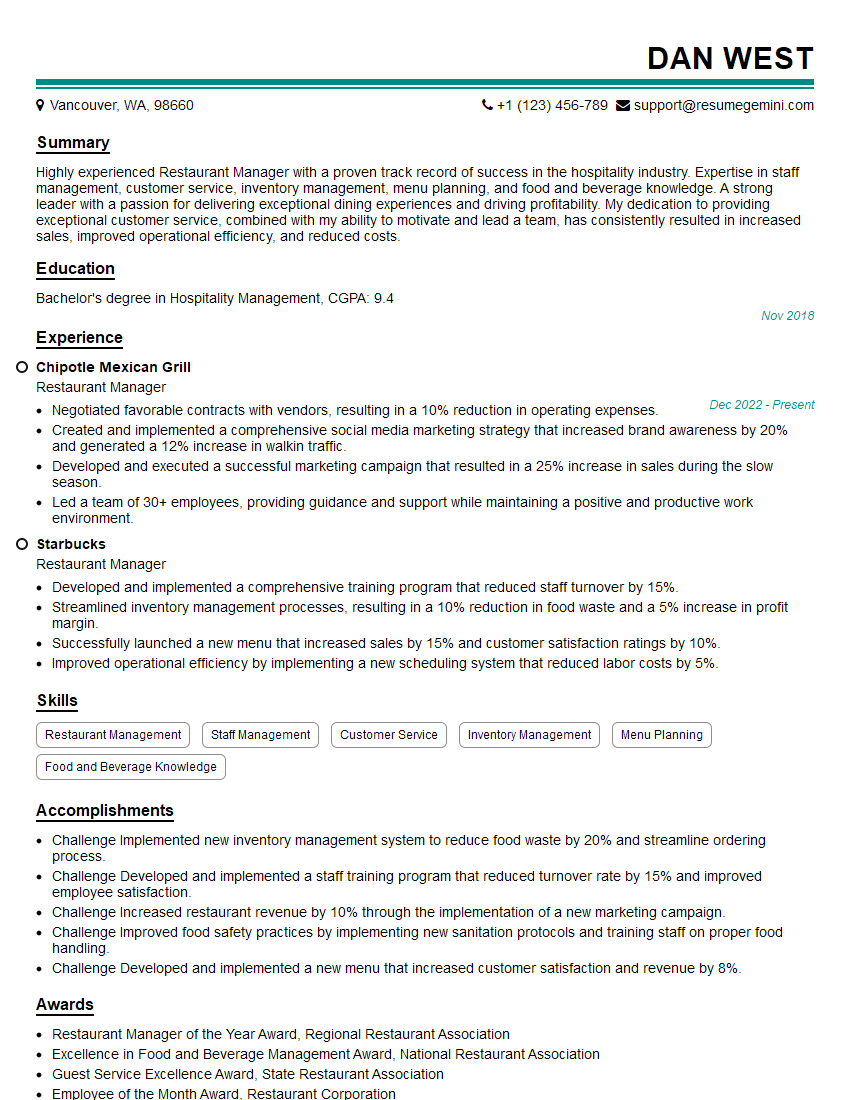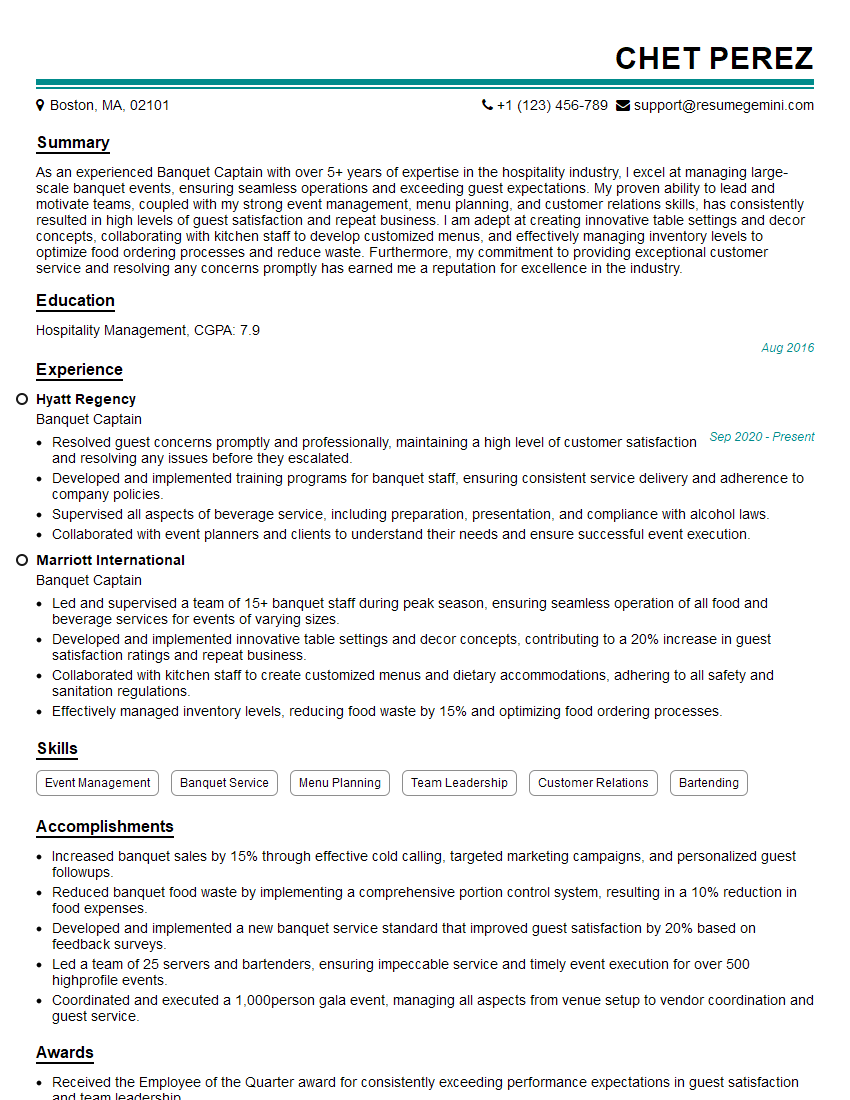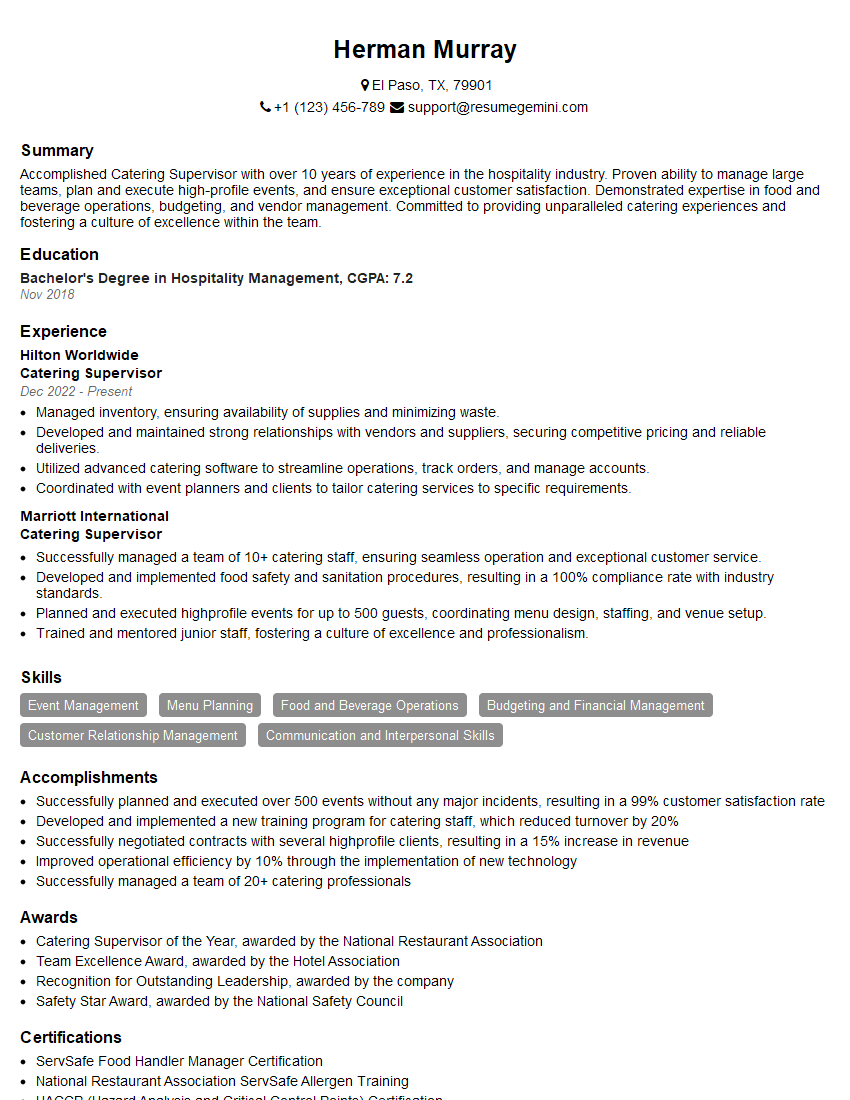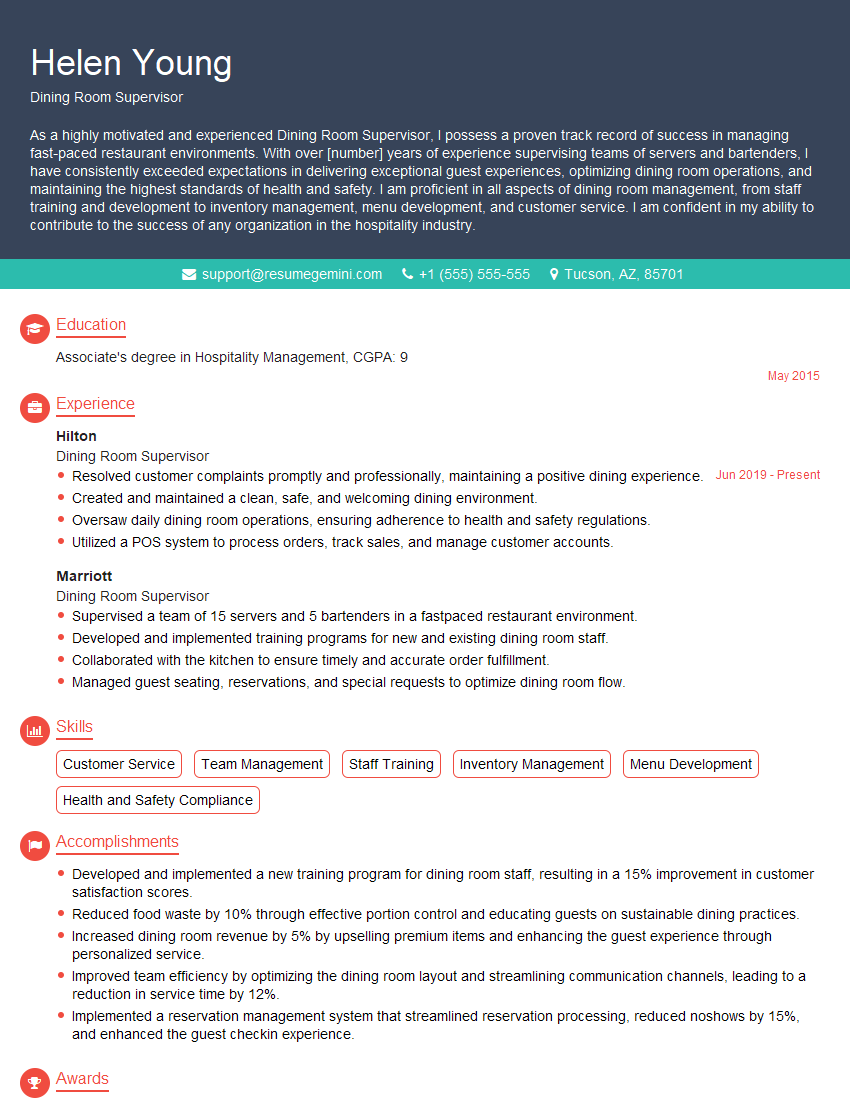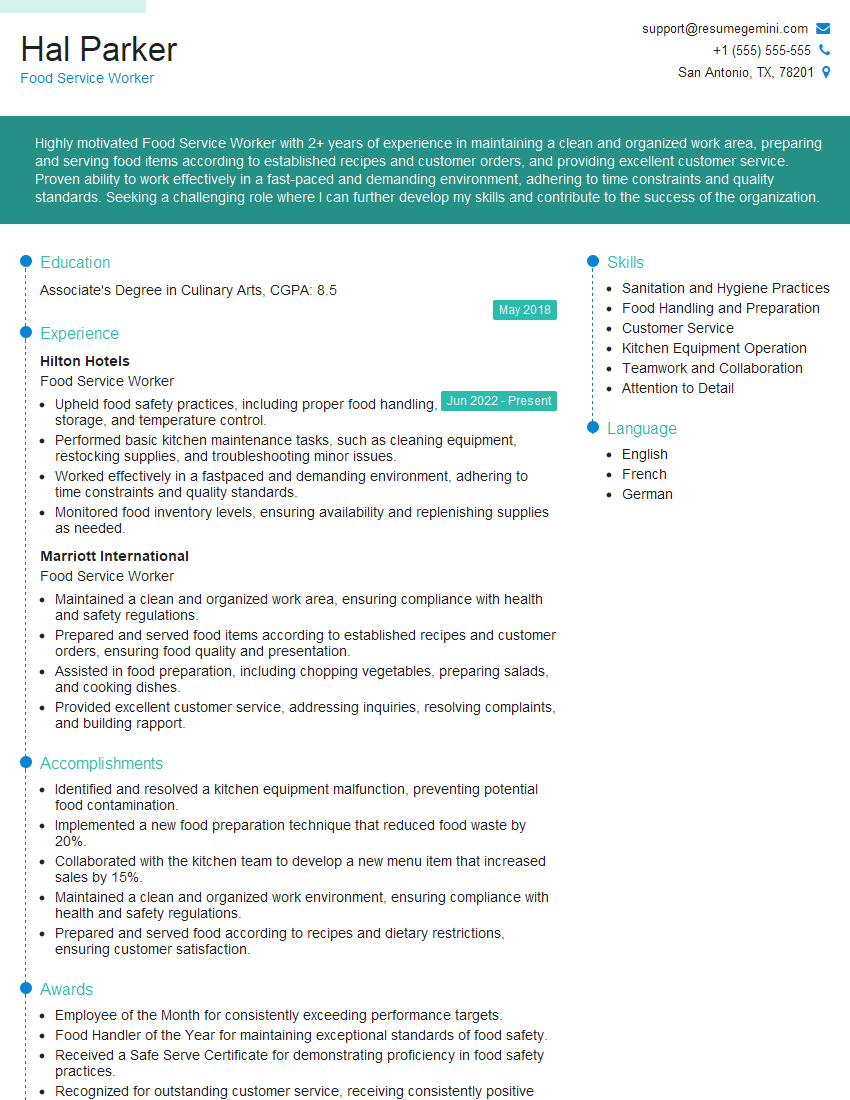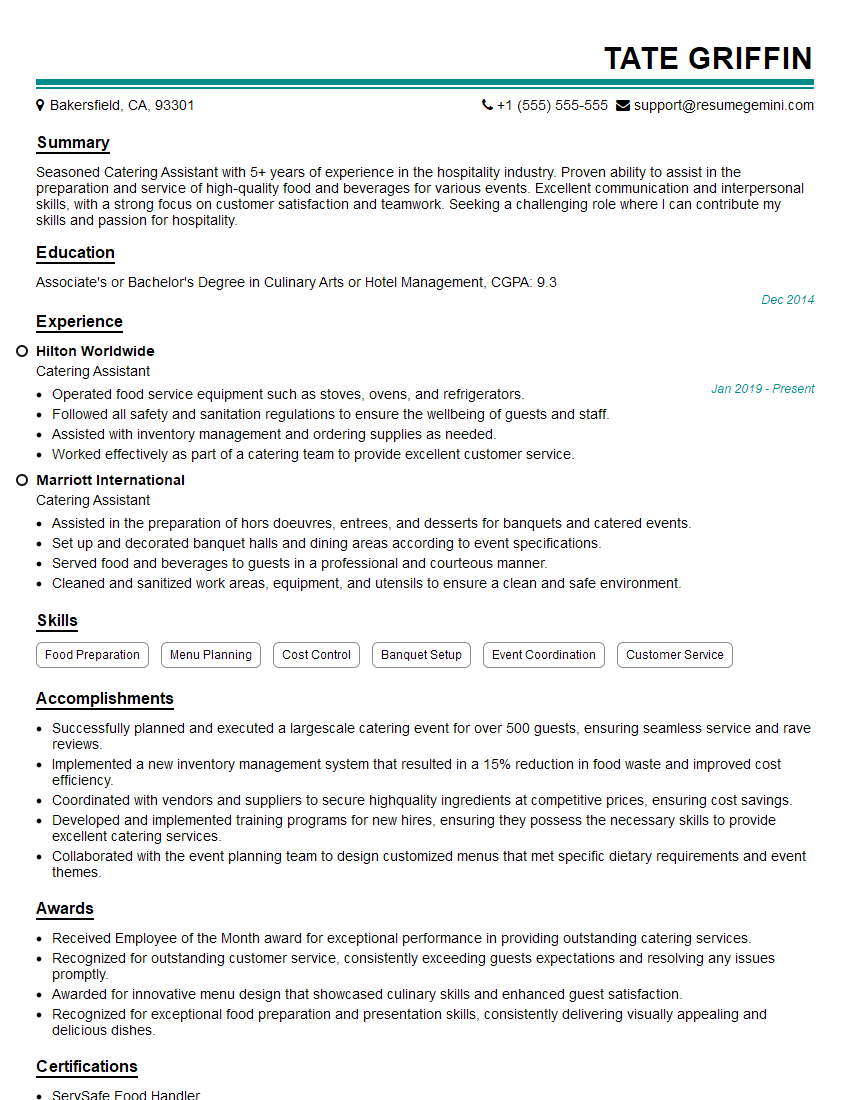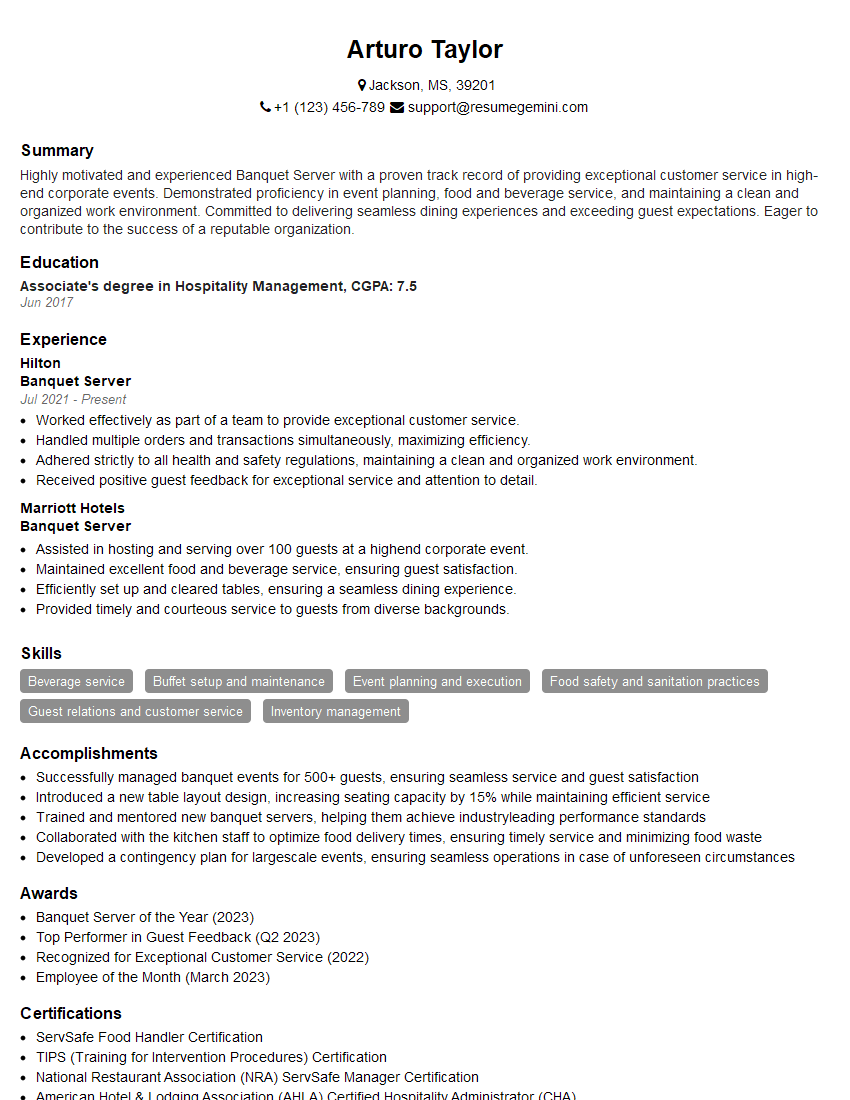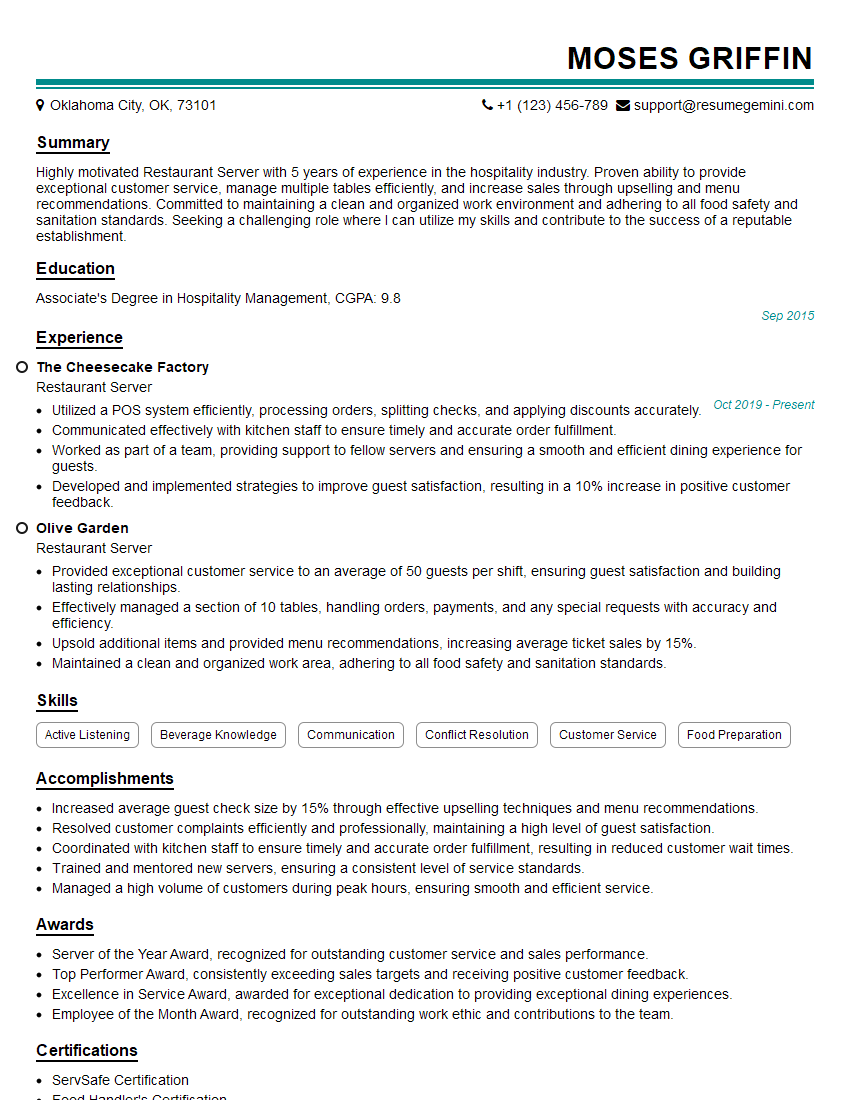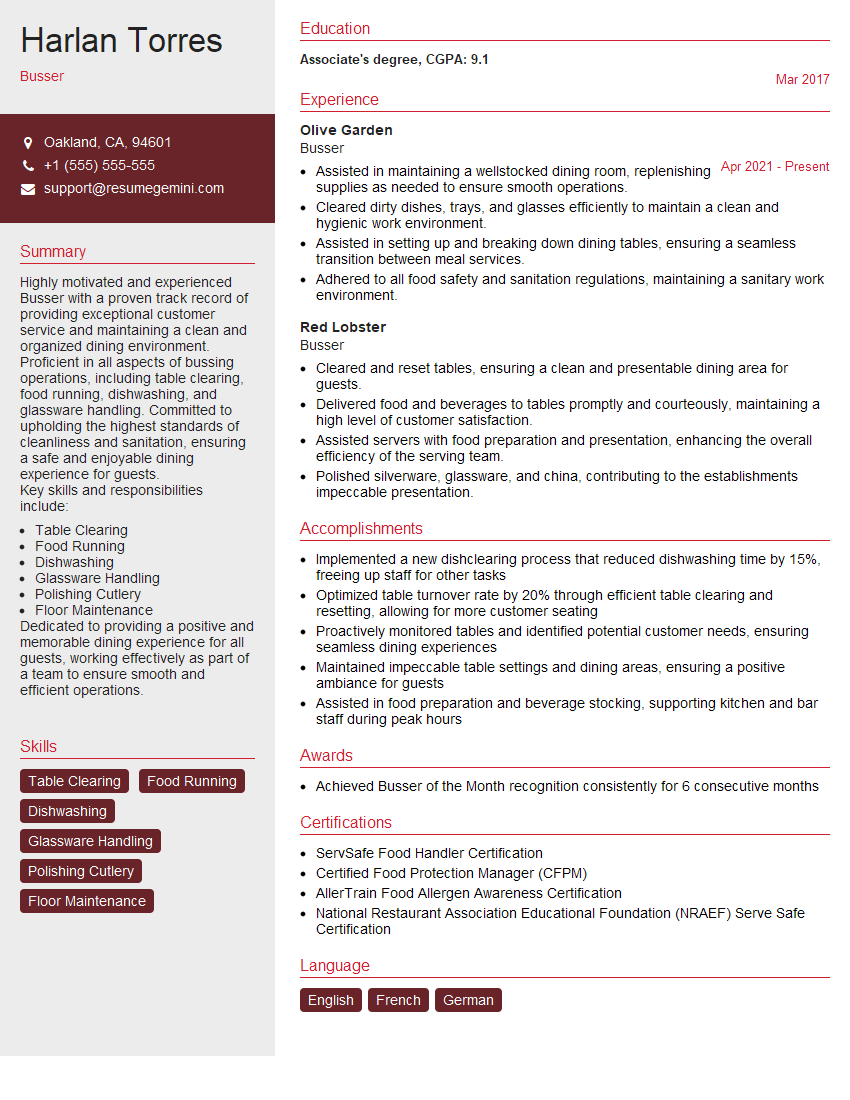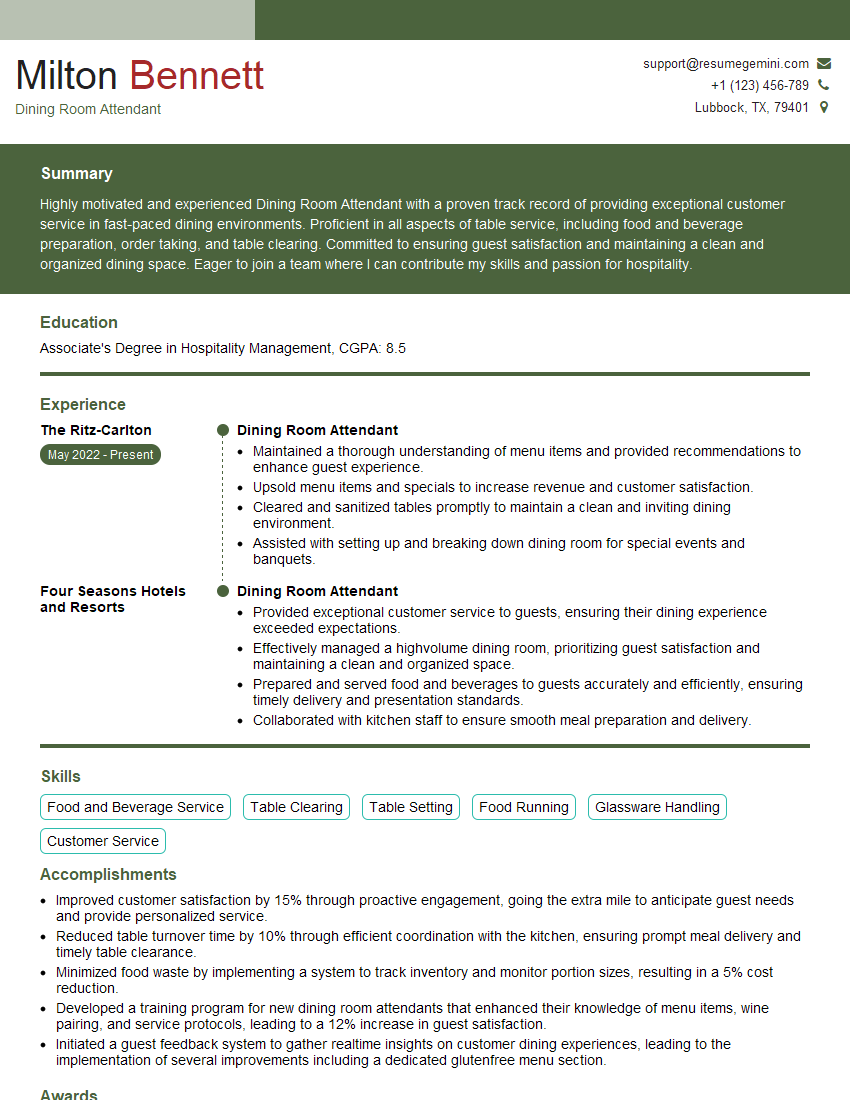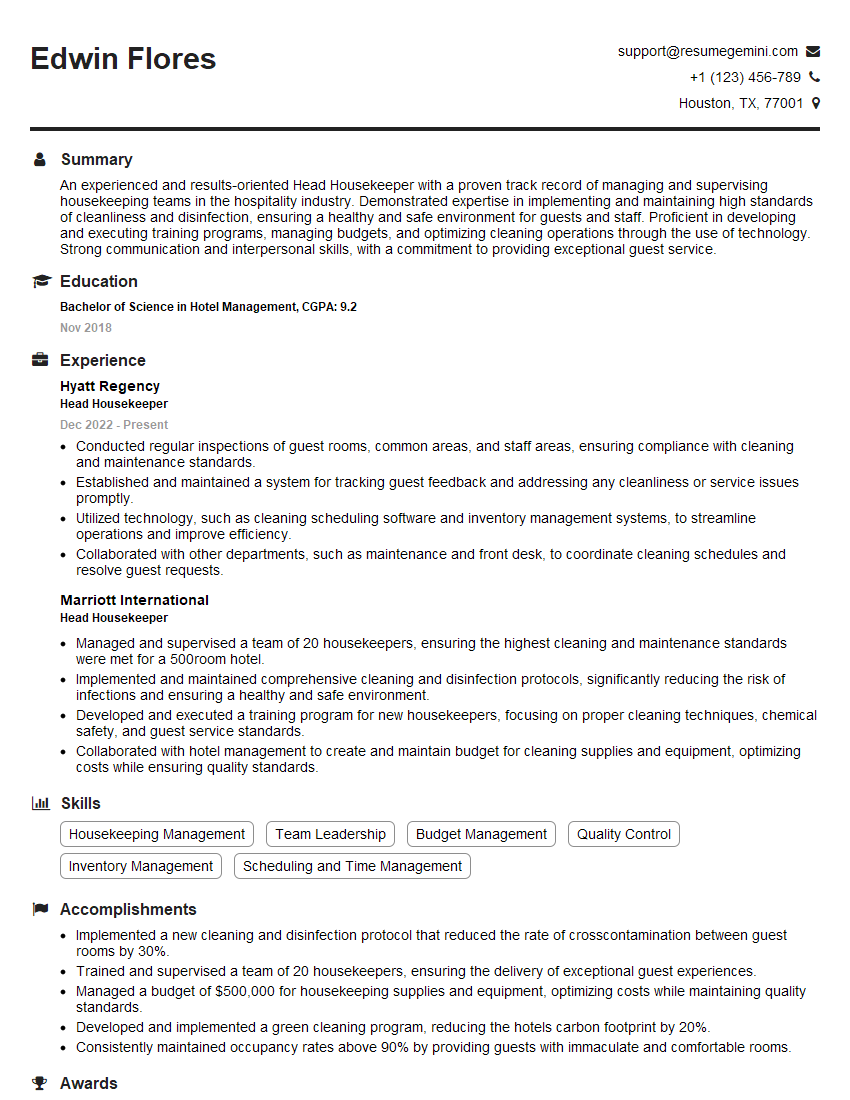Unlock your full potential by mastering the most common Setting Up and Breaking Down Dining Areas interview questions. This blog offers a deep dive into the critical topics, ensuring you’re not only prepared to answer but to excel. With these insights, you’ll approach your interview with clarity and confidence.
Questions Asked in Setting Up and Breaking Down Dining Areas Interview
Q 1. Describe your experience setting up tables for different event types (e.g., formal dinner, buffet, cocktail reception).
Setting up tables varies greatly depending on the event type. For a formal dinner, the focus is on elegance and precision. This involves meticulously placing chargers, silverware, glassware, and napkins according to established etiquette. A buffet, on the other hand, prioritizes ease of access and flow. Tables are often arranged in a linear fashion or in a U-shape, with ample space for guests to serve themselves. Cocktail receptions require a different approach entirely, focusing on creating a relaxed, mingling atmosphere. Smaller, higher tables might be used, along with strategically placed bar areas and appetizers.
- Formal Dinner: Imagine a wedding reception – each place setting might include a charger plate, dinner plate, salad plate, several forks and knives, wine glasses, water glasses, and a folded napkin. The arrangement follows a specific order, with utensils placed according to the order of courses.
- Buffet: Think of a large corporate luncheon – long tables are set up with food, and guests serve themselves. The focus is on ease of access and clear signage indicating what each dish contains. Smaller tables might be available for eating.
- Cocktail Reception: Picture a gallery opening – smaller, high-top tables are scattered around the space with minimal place settings, perhaps just a small plate for appetizers and a glass.
Q 2. What is your process for ensuring appropriate spacing between tables and chairs?
Appropriate spacing is crucial for guest comfort and flow. A good rule of thumb is to allow at least 24-30 inches between chairs at a table, and 48-72 inches (4-6 feet) between tables themselves. This allows for comfortable movement and conversation. For larger events, I use a floor plan to visualize table placement and ensure sufficient space, accounting for walkways and any special features, such as a dance floor or stage.
When setting up, I physically measure the spaces to ensure accuracy. It’s better to have a little extra space than to feel cramped. Consider the size of the chairs as well – some are larger than others. In smaller venues, efficient spacing is critical to maximize capacity without sacrificing comfort. For example, if space is limited, square tables might be preferred over round ones due to their footprint.
Q 3. How do you determine the appropriate number of place settings needed for an event?
Determining the number of place settings involves a straightforward calculation based on the expected guest count and RSVPs. Always add a few extra settings to account for unexpected guests or last-minute additions. For example, if I expect 100 guests, I might set up 105 places, offering a buffer for any unforeseen circumstances.
It’s essential to verify the RSVP count just before the event to make any necessary adjustments. This ensures a smooth setup without wasted resources or a shortage of seating. The type of event also influences the number of settings. A formal sit-down dinner necessitates a place setting for every guest, whereas a buffet or cocktail reception might have fewer assigned seats.
Q 4. Explain your method for linen placement and napkin folding.
Linen placement is crucial for a polished look. Tablecloths should hang evenly over the table’s edges, usually 8-12 inches. I always ensure there’s a clean, crisp look; if necessary, I’ll use table pads to create a smooth, even surface. Napkin folding styles can vary greatly depending on the event’s formality. Simple, elegant folds suit formal events; more creative folds are suitable for less formal occasions. Consistency is key – all napkins should be folded identically. Placemats are a nice alternative to tablecloths, especially for buffet-style events, providing a clean and protected surface for plates.
I often pre-fold napkins in advance to ensure efficiency and consistency during setup. There are numerous videos and resources demonstrating different napkin folds, which aids in ensuring uniform presentation.
Q 5. How do you handle different types of silverware and glassware arrangements?
Silverware and glassware arrangements follow a specific order, generally determined by the order of courses. Utensils are placed to the left and right of the plate, with forks on the left and knives and spoons on the right. Glassware is arranged above the knife, typically including water glasses, red wine glasses, and white wine glasses, if appropriate. Each piece should be placed meticulously to avoid cluttering the table. I also pay attention to the weight and size of the glassware and silverware to prevent imbalance or potential accidents.
For example, in a formal setting, the forks would be arranged from outside in, the order of usage, reflecting the meal progression. I will often use a chart as a reference to ensure accuracy and uniformity.
Q 6. What is your approach to efficiently and safely setting up multiple tables simultaneously?
Efficiently setting up multiple tables requires a systematic approach. I begin by assigning roles to my team, focusing on different tasks like linen placement, silverware arrangement, and glassware setup. I often have a pre-set plan, mapping out the table arrangements and identifying potential challenges before beginning the setup. I pre-stage the necessary materials near each table to minimize movement and wasted time. This parallel setup significantly improves efficiency and ensures a more uniform setup across all tables.
For example, one person might focus solely on placing tablecloths, while another sets out silverware. Clear communication and coordination between team members is key to maximizing efficiency and maintaining safety. We use a checklist to ensure all items are included at each place setting.
Q 7. Describe your experience with buffet setup, including food placement and chafing dish arrangements.
Buffet setup requires careful planning to ensure food safety and guest convenience. Food is arranged strategically, considering temperature and presentation. Hot dishes are placed in chafing dishes to maintain temperature. I also consider the flow of traffic – guests should be able to move easily through the buffet line without congestion. Clear signage indicating the contents of each dish is essential, especially if there are dietary restrictions to consider. Utensils and serving spoons are strategically placed to prevent cross-contamination. I often use disposable gloves to handle the food for hygiene reasons.
Chafing dishes should be strategically placed to maintain food temperature and prevent spills. I use a mix of high and low placements depending on the food and layout. For example, desserts might be on a lower, separate table, to clearly differentiate them from the main course.
Q 8. How do you ensure all serving utensils and condiments are correctly placed?
Correct placement of serving utensils and condiments is crucial for both aesthetics and efficient service. Think of it like a well-orchestrated ballet – each item has its designated spot to ensure smooth and graceful movement during the meal.
- Utensil Placement: Forks go on the left, knives on the right (blade facing the plate), and spoons to the right of the knives. Dessert spoons or forks are placed above the plate.
- Condiment Placement: Condiments are typically placed either on a central condiment stand or individually at each place setting. Salt and pepper shakers are usually paired. Consider the type of meal; a formal dinner might require more specific condiment placement than a casual buffet.
- Visual Appeal: Aim for symmetry and balanced placement. Avoid overcrowding the table. The arrangement should be visually appealing and easy for guests to access.
For example, at a formal wedding reception, you’d precisely arrange each piece of silverware and ensure that salt and pepper shakers, along with any other condiments, are neatly presented on small, appropriately sized serving dishes. In contrast, a casual barbecue might call for a simpler approach.
Q 9. How do you handle special requests or dietary restrictions during table setup?
Handling special requests and dietary restrictions requires careful planning and attention to detail. It’s about ensuring everyone feels included and catered for.
- Communication: Clearly communicate with the event organizer or client well in advance to gather all necessary information about dietary needs, allergies, and preferences (vegetarian, vegan, gluten-free, etc.).
- Seating Arrangements: When possible, designate specific seating areas or tables for guests with special dietary requirements to streamline service.
- Separate Preparation: Ensure that food for guests with allergies or restrictions is prepared separately to avoid cross-contamination. Clearly label all dishes.
- Utensil Considerations: For example, if someone has a nut allergy, ensure that utensils used for their food are not cross-contaminating with other food that contains nuts.
Imagine a wedding where a guest is a vegan. You’d need to pre-arrange a separate vegan meal and ensure that the serving utensils are completely separate to prevent any accidental cross-contamination.
Q 10. Describe your process for breaking down dining areas after an event.
Breaking down a dining area requires a systematic approach to ensure efficiency and prevent damage. Think of it as reverse engineering the setup process, but with even more emphasis on cleanliness and safety.
- Clear the Table: Start by removing all food, plates, silverware, and glasses. Bus trays or carts help speed up this process.
- Remove Centerpieces & Decorations: Carefully handle and remove centerpieces and table decorations. Set them aside to be stored or returned.
- Collapse Tables & Chairs: Fold up any foldable tables and stack chairs neatly. Be mindful of any specific folding instructions to avoid damage.
- Sweep & Wipe: Once the area is clear, give the floor a quick sweep and wipe down any spills.
- Transport Items: Use proper transportation equipment to move items to the designated storage areas safely and efficiently.
For instance, after a large corporate event, you’d meticulously clear every table, transport used items to the dishwashing area, and then stack the chairs carefully according to their weight and material to avoid damage and ensure proper storage.
Q 11. What steps do you take to ensure the efficient and timely removal of all items?
Efficient and timely removal is key to minimizing disruption and ensuring quick turnaround for the next event. A well-organized team and the right equipment are vital.
- Teamwork: Assign specific tasks to team members to optimize the process. Some can clear tables, others can transport items, and others can handle cleaning.
- Efficient Equipment: Utilize bus tubs, trays, dollies, and other equipment to transport large quantities of items simultaneously.
- Designated Drop-off Points: Establish clear drop-off points for different types of items (dishes, linens, trash, etc.) to reduce confusion and streamline the process.
- Checklists: Using checklists ensures that nothing is left behind and the process is performed consistently.
Imagine a large banquet hall – using multiple bus tubs and a well-coordinated team allows for rapid clearing and cleaning of several tables concurrently.
Q 12. How do you prioritize the order of cleaning and storing different items?
Prioritizing cleaning and storage ensures proper hygiene and prevents damage. Delicate items should be handled first to minimize the risk of breakage.
- Glassware: Handle glassware with care, washing and drying immediately to avoid breakage. Store glassware upside down on racks to prevent dust accumulation.
- Silverware: Wash and dry silverware thoroughly to prevent tarnishing. Store silverware in designated containers or trays.
- Linens: Separate linens according to type (tablecloths, napkins, etc.) and wash according to their care instructions. Store linens in clean, dry locations to avoid mildew or staining.
- Dishes: Wash and dry dishes efficiently. Store dishes according to their type and size to optimize space.
For example, after a formal dinner, you’d prioritize washing and storing fragile crystal glassware before tackling the bulkier dinner plates to avoid accidental chipping or breaking.
Q 13. Explain your method for cleaning and sanitizing tables and chairs.
Cleaning and sanitizing tables and chairs is crucial for maintaining hygiene. It involves a combination of cleaning and disinfection.
- Cleaning: First remove any loose debris from the tables and chairs using a broom, dustpan and brush.
- Disinfection: Use an appropriate sanitizing solution (check the manufacturer’s guidelines for dilution and application) to thoroughly clean all surfaces. Pay special attention to frequently touched areas such as armrests and tabletops. Let the disinfectant dwell for the recommended time.
- Drying: Allow the surfaces to air dry completely or wipe them with a clean, dry cloth.
- Regular Maintenance: Regular maintenance, such as polishing wooden tables and chairs, helps prevent deterioration and maintain a professional appearance.
Think of it like this: you wouldn’t just wipe a table down after a sticky drink spill – you’d want to clean and disinfect the entire surface to prevent bacteria growth. The same logic applies to all surfaces in the dining area.
Q 14. How do you handle any spills or damage during setup or breakdown?
Handling spills and damage requires quick action to minimize disruption and prevent further problems.
- Immediate Action: Address spills immediately to prevent staining or damage to surfaces. Use appropriate cleaning agents depending on the type of spill.
- Damage Assessment: Assess the extent of any damage to tables, chairs, or other items. Take photos for documentation purposes.
- Reporting: Report any significant damage or spills to the appropriate personnel.
- Repair or Replacement: Depending on the severity of the damage, arrange for repair or replacement of damaged items.
For instance, if a red wine spill occurs, you’d immediately act by blotting the spill with a clean cloth to avoid spreading, then use a suitable cleaning product, documenting the incident for the venue management.
Q 15. How do you ensure all linens and equipment are correctly stored after an event?
Proper storage of linens and equipment after an event is crucial for maintaining hygiene, extending their lifespan, and ensuring efficient setup for future events. My process involves a methodical approach, prioritizing cleanliness and organization.
- Cleaning and Inspection: All linens are inspected for stains or damage. Stained items are pre-treated and set aside for professional cleaning. Equipment is wiped down and cleaned, paying close attention to food residue.
- Folding and Sorting: Clean linens are carefully folded according to established standards (e.g., banquet folds for napkins, precise folds for tablecloths) and sorted by type and size. This allows for quick identification and retrieval for the next event.
- Storage: Linens are stored in designated, clean storage areas, ideally in breathable bags or containers to prevent mildew. Equipment is stored in its designated location, organized to maximize space and accessibility. Heavy items are stored lower to avoid strain and potential accidents.
- Inventory Management: A detailed inventory system is maintained to track the quantity and condition of all linens and equipment. This allows for timely replenishment and prevents shortages.
For example, I’ve worked events where over 200 napkins were used. The meticulous folding and sorting ensured a smooth and quick set-up for the next event, saving significant time and effort.
Career Expert Tips:
- Ace those interviews! Prepare effectively by reviewing the Top 50 Most Common Interview Questions on ResumeGemini.
- Navigate your job search with confidence! Explore a wide range of Career Tips on ResumeGemini. Learn about common challenges and recommendations to overcome them.
- Craft the perfect resume! Master the Art of Resume Writing with ResumeGemini’s guide. Showcase your unique qualifications and achievements effectively.
- Don’t miss out on holiday savings! Build your dream resume with ResumeGemini’s ATS optimized templates.
Q 16. What safety precautions do you follow during setup and breakdown?
Safety is paramount during setup and breakdown. My approach incorporates a layered safety strategy, anticipating potential hazards and taking proactive steps to mitigate risks.
- Risk Assessment: Before starting, I conduct a thorough risk assessment of the venue, noting potential hazards like uneven flooring, electrical outlets, and obstacles.
- Safe Lifting Techniques: I always use proper lifting techniques to avoid strain and injury. Heavy items are lifted with the legs, keeping the back straight and using appropriate equipment when necessary (e.g., dollies for large tables).
- Sharp Objects and Hot Surfaces: Care is taken to handle knives, glassware, and hot equipment safely. Designated areas are used for placing hot dishes and sharp objects are handled with caution, especially in high-traffic areas.
- Electrical Safety: I always ensure that electrical cords are properly routed and away from walkways to prevent tripping hazards. I also check equipment for any signs of damage before use.
- Teamwork and Communication: Clear communication within the team ensures everyone is aware of potential hazards and working safely. This includes designating specific roles and responsibilities during both setup and breakdown.
For instance, during a recent outdoor event, I noticed uneven ground. To avoid accidents, I strategically positioned tables on level surfaces and warned the team to exercise extra caution when moving equipment.
Q 17. What is your experience with different types of tablecloths and runners?
My experience encompasses a wide range of tablecloths and runners, including various materials, colors, and styles. Understanding their properties is essential for choosing the right ones for each event.
- Materials: I’m familiar with linen, cotton, polyester, and blends. Linen offers elegance and durability but requires more care, while polyester is more wrinkle-resistant and easier to clean. Cotton provides a good balance of both.
- Colors and Patterns: I can select tablecloths and runners that complement the event’s theme and décor. I understand the impact of color psychology and can use them effectively to create a specific ambiance.
- Sizes and Shapes: I have experience working with different table shapes (round, rectangular, square) and sizes, ensuring the proper fit of tablecloths and runners for each.
- Maintenance and Care: I understand the specific cleaning and care instructions for various materials to ensure their longevity.
For example, a formal wedding might call for crisp linen tablecloths with elegant runners, while a casual outdoor barbecue might be better suited to more durable, easily cleaned polyester options. I can advise clients on the best choice based on their budget and the event’s style.
Q 18. How do you handle situations where you have to adapt to unexpected changes in the event setup?
Adaptability is key in this profession. Unexpected changes are common – a sudden increase in guest count, a last-minute change in seating arrangements, or a delivery delay. My strategy involves remaining calm, assessing the situation, and finding creative solutions.
- Communication: I immediately communicate with the event coordinator or client to understand the nature and scope of the change.
- Prioritization: I prioritize tasks based on their urgency and impact on the event’s success. Critical aspects, such as seating and food service, take precedence.
- Resourcefulness: I explore available resources, such as alternative table arrangements, extra linens, or available staff, to address the change effectively.
- Problem-Solving: I calmly assess the problem and implement a solution in the most efficient and practical manner, involving my team where necessary.
For instance, I once had a last-minute increase in guest count. I quickly assessed the available space, rearranged tables, and borrowed additional chairs from a neighboring venue. Through clear communication and quick thinking, we successfully accommodated the extra guests.
Q 19. Describe a time when you had to troubleshoot a problem during event setup or breakdown.
During a large corporate event, we discovered a significant mismatch in the delivered tablecloths – we were short by 20. The event was about to start, and panic threatened to set in.
My first step was to remain calm and assess the situation. We immediately contacted the linen supplier, but the replacement wouldn’t arrive on time. I then worked with the team to prioritize the most essential areas – the head table and VIP seating – ensuring those were perfectly set up. We then creatively repurposed smaller tablecloths and runners to cover the remaining tables, and strategically used centerpieces to mask the mismatched linens. The situation was handled discreetly, ensuring the event went on flawlessly. This incident highlighted the importance of having a contingency plan and the ability to think on your feet.
Q 20. How do you maintain a high level of efficiency while working under pressure?
Maintaining efficiency under pressure relies on meticulous planning, effective teamwork, and a focus on systematic execution.
- Detailed Planning: I create detailed checklists and schedules to outline each step of the setup and breakdown process. This ensures I can easily track progress and anticipate potential delays.
- Teamwork: I delegate tasks effectively, matching team members’ skills and experience to each job. Clear communication and collaboration are essential to maintaining momentum.
- Time Management: I prioritize tasks based on urgency and deadlines, ensuring the most critical aspects are addressed first. I break down large tasks into smaller, more manageable steps.
- Stress Management: I stay calm under pressure by maintaining a positive attitude and focusing on the task at hand. Taking short breaks when possible can help to maintain energy and concentration.
In a fast-paced environment, a proactive, organized approach ensures that even under pressure, the final result is efficient and executed to the highest standards.
Q 21. How familiar are you with different types of seating arrangements?
I’m very familiar with various seating arrangements, and I understand how different layouts impact the flow of an event and the overall guest experience. My knowledge includes:
- Classroom Style: Rows of chairs facing forward, ideal for lectures or presentations.
- Theater Style: Rows of chairs facing a stage, perfect for performances or large presentations.
- Banquet Style: Round or rectangular tables, commonly used for formal dinners or conferences.
- Cocktail Style: High-top tables with minimal seating, creating a more informal and interactive atmosphere.
- U-Shape: Tables arranged in a U-shape, promoting interaction and discussion.
- Hollow Square: Tables forming a square with an open space in the middle, excellent for breakout sessions or interactive workshops.
Selecting the right arrangement depends on the event’s purpose, guest count, and desired ambiance. I can help clients choose the optimal layout and ensure seamless execution.
Q 22. What is your experience with setting up and using banquet equipment?
My experience with banquet equipment is extensive. I’m proficient in setting up and breaking down a wide range of equipment, including various table sizes and shapes, chairs, linens, silverware, glassware, and buffet setups. I understand the importance of proper assembly and disassembly to ensure safety and prevent damage. For example, I know the correct techniques for stacking chairs to minimize space and avoid tipping, and I’m meticulous about storing linens properly to prevent wrinkles and staining. I also have experience with more specialized equipment like chafing dishes, serving platters, and even staging for live events. I’m familiar with different brands and models and understand the best practices for maintaining their functionality and longevity.
Q 23. Explain your knowledge of proper table etiquette and setting standards.
Proper table etiquette and setting standards are crucial for creating a professional and welcoming dining experience. My knowledge encompasses both formal and informal settings. In a formal setting, this includes the precise placement of cutlery, glassware (water goblet, wine glasses), napkins, and chargers, following a specific order and orientation relative to the plate. For example, forks go on the left, knives on the right with the blade facing the plate, and spoons to the right of the knives. The bread plate is placed to the upper left, and the water glass is positioned above the knife. Informal settings are less rigid, but still require attention to detail, ensuring consistency and a pleasing aesthetic. I understand the nuances of different cultures and can adapt table settings accordingly.
Q 24. Describe how you coordinate with other staff members during setup and breakdown.
Coordination with other staff members is paramount for efficient setup and breakdown. We typically use a team-based approach, assigning roles based on individual strengths and experience. Before starting, we always have a brief discussion to review the event layout, confirm the number of guests, and assign tasks, such as linen placement, tableware setup, buffet arrangement, etc. Clear communication is crucial throughout the process. We use hand signals or quiet communication during the event itself to avoid disturbing guests. Post-event, we work together to dismantle the setup quickly and efficiently. We follow a predetermined sequence to avoid confusion and ensure that all equipment is safely and correctly stored.
Q 25. How do you ensure that the dining area is clean and organized before and after an event?
Maintaining a clean and organized dining area is a top priority. Before an event, I thoroughly clean and sanitize all surfaces, including tables, chairs, and buffet areas. I ensure that all equipment is spotless and in proper working order. Following an event, the process is more rigorous. We meticulously clear all tables and remove trash and debris. All used tableware and glassware are immediately washed and sanitized. We carefully inspect the entire area to ensure no items are left behind. Finally, we restore the space to its original state, leaving it ready for the next event. We follow strict hygiene protocols and use appropriate cleaning supplies.
Q 26. What are some common mistakes to avoid when setting up a dining area?
Common mistakes to avoid include inconsistent table settings, overcrowding the tables, incorrect placement of cutlery, neglecting to check chair stability, and improper linen placement resulting in wrinkles or slippage. Other crucial points include ensuring sufficient space between tables for guest movement and access for service staff. Using incorrect glassware or cutlery for the event’s style and menu can also impact the presentation. Finally, not having backup equipment on hand for unexpected issues could lead to delays or disruptions. By paying close attention to these details, we can guarantee a smooth and professional experience for all involved.
Q 27. Describe your experience with handling different table sizes and shapes.
I have extensive experience working with a variety of table sizes and shapes, from small round tables for intimate gatherings to large rectangular tables for banquet events. My knowledge includes adapting table settings to fit different shapes and sizes while ensuring aesthetic consistency. For instance, the placement of centerpieces might need adjustment depending on the table’s dimensions and shape. I understand how to effectively space chairs to ensure guest comfort and proper flow around the table. I also consider the table’s dimensions when choosing the right tablecloth size and style.
Q 28. How do you maintain a professional demeanor while working in a fast-paced environment?
Maintaining a professional demeanor in a fast-paced environment requires a calm and organized approach. I prioritize time management and anticipate potential challenges. This includes proactively organizing tasks and communicating effectively with colleagues. I handle stress by remaining focused and prioritizing tasks according to urgency. I always maintain a polite and helpful attitude towards colleagues and guests. Even under pressure, I focus on providing excellent service and maintaining a positive atmosphere. I understand that a positive attitude is contagious and helps the entire team to stay focused and efficient.
Key Topics to Learn for Setting Up and Breaking Down Dining Areas Interview
- Understanding Different Dining Styles: Learn the nuances of various table settings (formal, informal, buffet, etc.) and how to adapt your setup accordingly. This includes understanding place settings, silverware arrangement, and linen choices.
- Efficient Setup Procedures: Mastering the workflow of setting up a dining area quickly and effectively. This includes optimizing space utilization, managing resources (linens, silverware, glassware), and maintaining a consistent standard of quality.
- Safety and Hygiene Practices: Demonstrate your knowledge of food safety regulations, proper handling of utensils and linens, and maintaining a clean and sanitized work environment. This is crucial for creating a positive dining experience.
- Breakdown and Cleaning Procedures: Explain your approach to efficiently and thoroughly breaking down a dining area after service, including proper cleaning and storage of all materials. Highlighting your understanding of waste management is also beneficial.
- Problem-Solving and Adaptability: Prepare examples of how you have handled unexpected challenges, such as last-minute changes in the number of guests or damaged equipment. Highlight your ability to think on your feet and find creative solutions.
- Teamwork and Communication: Discuss how you collaborate effectively with colleagues during setup and breakdown, ensuring smooth operations and maintaining a positive team dynamic. Effective communication is key to efficient workflow.
- Inventory Management: Explain your understanding of the importance of maintaining proper inventory of dining equipment, supplies, and linens, and how to identify and address shortages or potential issues.
Next Steps
Mastering the skills of setting up and breaking down dining areas is crucial for career advancement in the hospitality industry. It demonstrates efficiency, attention to detail, and a commitment to providing excellent service. To enhance your job prospects, creating a strong, ATS-friendly resume is essential. ResumeGemini is a trusted resource that can help you build a professional and effective resume tailored to your skills and experience. Examples of resumes tailored specifically to Setting Up and Breaking Down Dining Areas are available to help you get started. Take the next step and build a resume that showcases your expertise!
Explore more articles
Users Rating of Our Blogs
Share Your Experience
We value your feedback! Please rate our content and share your thoughts (optional).
What Readers Say About Our Blog
This was kind of a unique content I found around the specialized skills. Very helpful questions and good detailed answers.
Very Helpful blog, thank you Interviewgemini team.
